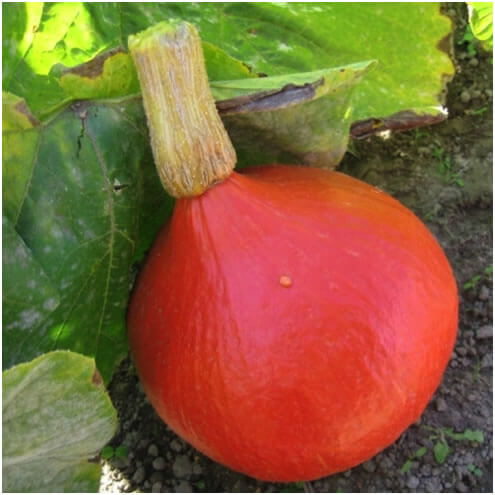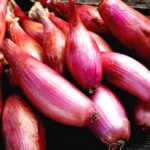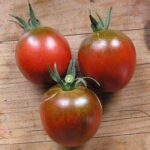Squash – Uchiki Kuri
€2.95
Description
Squash – Uchiki Kuri is one of the most reliable squashes to grow. It has orange/red pear shaped fruits along with a nutty flavour. Well worth trying. Highly recommended for its taste and also it’s reliability.
Sowing:
Mid April until late May.
Sow individual seeds into small pots (7cm) or large modules and keep in a warm place. Pot on into a 10cm pot when ready. Plant out in late May-June after hardening off. Initial protection with a cloche is beneficial.
Spacing:
Between plants: 1.2m
Approx. seed count: 5
Growing Squash – Uchiki Kuri
Family:
Cucurbitaceae
Related to:
Courgette, marrow, cucumber and melon.
Introduction:
Squash – Uchiki Kuri are one of the most vigorous vegetables. They cover an area of 5 square meters, rambling over any neighbouring crop. Thus they are not well suited to a small garden. You can, however, experiment growing them in more unusual places – for example: on top of an old compost heap, up trellises etc.
Squash – Uchiki Kuri are grown for storage. The fruit is harvested in October before the first frost and stored. There is a massive choice of varieties available. Imature fruits of winter squash can also be used throughout the season.
History:
The name ‘Squash’ is an abbreviation of the native American word askutashash which means ‘eaten raw or uncooked’.
Soil and site:
Squashes need a very fertile, free-draining soil which can hold plenty of moisture. Therefore, a generous application of well-decomposed compost is beneficial (about 1 bucket per square meter).
They also need a sheltered place in the garden because they really despise strong wind.
Sowing:
Squash – Uchiki Kuri are very tender plants.
I usually sow seeds in early May individually into 7cm pots. The pots are left ideally in a propagator in the greenhouse or on the windowsill at home (south facing). They may also be okay in a tunnel without a propagator, but plants have to be covered up with fleece during cold spells to protect them from frost damage.
After about 3 weeks – or before the plants get pot bound – I pot them on into 12cm pots which are still left in the greenhouse or indoors.
Planting:
Start hardening the plants off at the end of May and plant out in early June. However, do not plant if the weather forecast predicts cold windy spells which are quite common during this time.
The safest way would be to plant them under cloches which are covered with bio-net.
Rotation:
Squashes belong to the cucurbit family. Because this family is not prone to any soil borne pests and diseases, you do not need to be too fussy with rotations.
Plant care:
Keep the plants weed free, especially in the early stages as it will be very difficult later on to get to the weeds. If it is well weeded at the start the large leaves will prevent new seeds from germinating.
As with pumpkins, squashes may try to grow over neighbouring vegetables, so they need to be kept in check, either by shortening some shoots or by moving them back to their allocated space.
Hand pollination: In cold, wet weather (when few insects are around) you can pollinate the flowers by hand. This will increase your chances to get fruits.
Squash plants have separate male and female flowers. They are easily distinguished by looking at the flower stalk. The male stalk is plain and the female flower carries a small fruit on the stalk.
You transfer the pollen from the male to the female flowers with a soft brush or remove the male flower and rub it onto the open blooms of the female flowers.
Harvesting and storing:
If you want to store Squash – Uchiki Kuri, it is important to leave the fruits to mature on the vine at least until October. The mature fruits have hard outer shells. Use a sharp knife to cut the stems (or handles) of the fruits to be stored. It is equally important to leave the stem attached to the fruit. If the leaves of the plants are still green that means that the fruit is not yet cured and will not store for long. You should then leave the fruits out in a sunny spot for about ten days and only move them in if frost threatens. They will then store in a dry, fairly cool location until March.
Potential problems:
Squash plants need to be protected from slugs at the early stages straight after planting out. Also like all other cucurbits they are very sensitive to cold and windy weather. Additionally it is highly beneficial to plant them under a cloche covered with bionet for the first month.
During unfavourable weather they may fail to set fruit. You may have to do some ‘artificial insemination’.
How much to grow?
Two to three plants are sufficient otherwise you will have no room left for anything else. Squashes, however are exciting plants to grow and the fact that there are so many different varieties around, makes it very difficult to restrict yourself to just a few plants.
Varieties:
Types of winter squash:
- Crown Prince F1 (large squash with grey blue skin and delicious flavour)
- Buttercup (Sweet Mama)
- Butternut
- Little Gem (Rolet)
- Hubbard (Uchiki Kuri)
Types of summer squash:
- Vegetable Spaghetti (the fruit can be baked whole and also the flesh can be scooped out – it looks like spaghetti)
- Patty Pan types (Varieties: Sunburst F1 or White Patty Pan; they have an unusual flattened shape with a scalloped edge)
- Crooknecks
- Straightnecks
Why not subscribe to my monthly gardening newsletter?
https://greenvegetableseeds.com/newsletters/
A good information for all gardening news is the Irish Garden Magazine:




